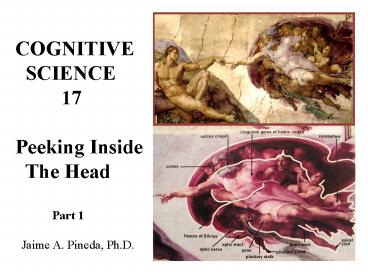Cognitive Neuroscience Techniques - PowerPoint PPT Presentation
Title:
Cognitive Neuroscience Techniques
Description:
COGNITIVE SCIENCE 17 Peeking Inside The Head Part 1 Jaime A. Pineda, Ph.D. Imaging The Living Brain Computed Tomography (CT) Magnetic Resonance Imaging (MRI) Positron ... – PowerPoint PPT presentation
Number of Views:644
Avg rating:3.0/5.0
Title: Cognitive Neuroscience Techniques
1
COGNITIVE SCIENCE 17 Peeking Inside
The Head Part 1 Jaime A. Pineda,
Ph.D.
2
Imaging The Living Brain
- Computed Tomography (CT)
- Magnetic Resonance Imaging (MRI)
- Positron Emission Tomography (PET)
- Functional MRI (fMRI)
- Electroencephalography (EEG)
- Magnetoencephalography (MEG)
3
CT Scans(1970s)
- X-ray scanner rotated 1o at a time over 180 o
- Contrast agent
- Computer reconstruction
- Horizontal sections
- Reveal structural abnormalities, such as cortical
atrophy or lesions caused by a stroke or trauma.
4
Computerized Axial Tomography
5
MRI Scans(1980s)
- A strong magnetic field (10-30k X) causes
hydrogen atoms to align in the same orientation.
- When a radio frequency wave is passed through the
head, atomic nuclei emit electromagnetic energy
(NMR) as they relax. - The MRI scanner is tuned to detect radiation
emitted from the hydrogen molecules. - Different types of tissue produce different RF
signals - Computer reconstructs image.
6
MRI vs. CT Scans
- Advantages of MRI
- No ionizing radiation exposure
- Better spatial resolution
- Horizontal, Frontal or Sagittal planes
- Disadvantages
- Cost
- No metal!
- noisier
7
Hemodynamic Techniques
- Oxygen and glucose are supplied by the blood as
fuel for the brain - The brain does not store fuel, so
- Blood supply changes as needs arise
- Changes are regionally-specific following the
local dynamics of neuronal activity within that
region - These techniques show where functional activity
occurs
8
PET Scans
- A positron emitting radionuclide is injected
(e.g., 2-deoxyglucose, - 15O radioactive oxygen).
- Positrons interact with electrons which produce
photons (gamma rays) traveling in opposite
directions. - PET scanner detects the photons.
- Computer determines how many gamma rays from a
particular region and a map is made showing areas
of high to low activity. - 10 mm resolution invasive
9
What PET Can Do
10
(No Transcript)
11
PET vs. CT Scans
- CT images brain structure.
- PET images brain function.
- CT involves absorption of X-rays.
- PET involves emission of radiation by an injected
or inhaled isotope.
12
Functional MRI (fMRI)(1990s)
- Images brain hemodynamics
- Blood oxygen level dependent (BOLD) signal
- Advantages over PET
- No injections given
- Structure and Function
- Shorter imaging time
- Better spatial resolution
- 3-D images
- Check out this website for more info on fMRI
methods http//www.fmri.org/fmri.htm
13
Brain Regions Impaired by Alcoholism
Non alcoholic
Alcoholic
14
Psychophysiology
- Electroencephalography (EEG)
- Electromyography (EMG)
- Electrooculography (EOG)
- Electrodermal activity (Skin Conductance)
- Cardiovascular activity
- Heart rate (EKG)
- Blood Pressure
- Plethysmography
15
Seizure
Normal
16
Signal Averaging
Event-related Potentials (ERPs)
- Background EEG signal can be removed by
trial-averaging revealing the response of a brain
region to stimuli
17
(No Transcript)
18
(No Transcript)
19
Electroencepholography
- Non-invasive
- High temporal resolution
- Direct reflection of neuronal activity
- Less expensive than fMRI or PET
- Poor spatial localization due to recordings made
at the scalp - Better suited to answering questions about when
cognitive processes work not where they work
20
(No Transcript)
21
Transcranial Magnetic Stimulation
- Coil placed over target brain region
- Cognitive failures recorded
22
Techniques Used With Nonhuman Animals
- Stereotaxic Surgery
- Lesion Methods
- Electrical Stimulation
- Electrophysiological Recording
23
Lesioning Techniques
- Aspiration lesions
- Radio-frequency lesions
- Knife cuts
- Cryogenic blockade
- Chemical Lesions
24
Neurohistology Techniques
- Fixation, preservation of tissue, sectioning and
staining of tissue - Uses of histological techniques
- Confirming lesion sites or electrode locations
- In combination with neural tracing techniques
(anterograde, retrograde labeling) - Autoradiography or Immunohistochemistry
25
Neurohistology Techniques
- Nissl Stains
- e.g., cresyl violet
- cell bodies
- Golgi Stain
- whole neurons
- Myelin Stains
- myelin
- For more info., see web site
- http//education.vetmed.vt.edu/Curriculum/VM8054/L
abs/Lab9/Lab9.htm
26
Electrophysiology Techniques
- Intracellular unit recording
- Extracellular unit recording
- Multiple-unit recording
- Patch clamping
27
Pharmacological Methods
- Measuring Chemical Activity
- 2-DG Autoradiography
- In vivo microdialysis
- Localizing Neurotransmitters and Receptors
- Immunocytochemistry
- In situ hybridization
28
Genetic Engineering
Transgenic mice
- Gene Knockout Techniques
- Gene Replacement Techniques
29
Behavioral Research Methods
- NEUROPSYCHOLOGICAL TESTING
- Intelligence (e.g., WAIS, WISC)
- Verbal Subtests
- Information, digit-span, vocabulary, arithmetic,
comprehension, similarities - Performance Subtests
- Picture-completion, picture-arrangement, block
design, object assembly, digit-symbol substitution
30
Neuropsychological Testing
- Language (lateralization)
- Sodium amytal test
- Dichotic listening test
- Language deficits
- Phonology
- Syntax
- Semantics
31
Neuropsychological Testing
- Memory
- STM, LTM
- Explicit, Implicit
- Semantic, Episodic
- Frontal Lobe Function
- Wisconsin Card Sorting Task
32
Animal Behavior Paradigms
- Species-common behaviors
- Aggressive Behaviors
- Defensive Behaviors (e.g., anxiety paradigms)
- Reproductive Behaviors
- Locomotor Activity
- Traditional Conditioning Paradigms
- Pavlovian (Classical) Conditioning
- Operant Conditioning
33
Animal Behavior Paradigms
- Open Field Apparatus
34
Animal Behavior Paradigms
- Operant Conditioning Apparatus
35
Animal Behavior Paradigms
- Common Learning Paradigms
- Conditioned Taste Aversion
- Conditioned Avoidance
- Radial Arm Maze
- Morris Water Maze
- Conditioned Defensive Burying
36
Animal Behavior Paradigms
- Radial Arm Maze































